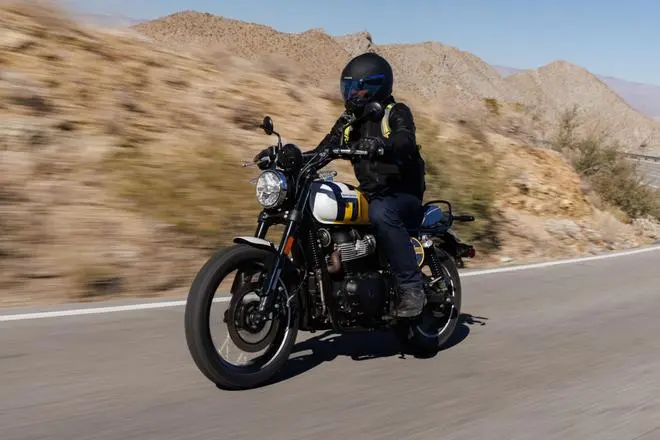There’s no stopping Royal Enfield from widening its line-up of motorcycles to the point that nearly every platform gets multiple variations, thereby ensuring the customer doesn’t need to go elsewhere looking for their perfect bike. The latest to be inducted into this programme is a neatly styled example, called the Bear 650. It’s a scrambler-style version of the Interceptor, but it’s not just a mix and match of parts, as I found out on the first ride. It’s instead a carefully engineered motorcycle that won’t alienate new buyers but also not disappoint those who want a playful motorcycle ready to handle a mix of riding scenarios including off-road trails. So, how is it?
Quite good, actually, even if you’re coming from an Interceptor 650. It’s a mild-scrambler version, so utmost care has been taken to ensure the motorcycle isn’t too focussed or hardcore. Its frame might be the same as the Interceptor’s, but it gets new 43 mm Showa USD forks, twin shocks at the rear, a longer wheelbase, more ground clearance, and increased seat height, too. Its longer suspension travel is complemented by block-pattern tyres — 19-inch at the front and 17-inch at the rear. The exhaust system is also different; it’s a 2-in-1 setup, with the end can positioned under the engine.

At ₹3.39 lakh, it’s full of character, seems promising on good roads and won’t mind an occasional off-road detour, either
A scrambler handlebar is standard, a digital TFT console (from the new Himalayan) finds its way to the Bear 650, and the flat-track-style oval side panels help the motorcycle stand out, in addition to the choice of characterful colour schemes. There’s LED lighting all around, the rear gets a round taillamp, and the motorcycle gets some new-age features like USB-C connectivity, media controls, and onboard navigation. The seat height seemed perfect for my 5’11” frame for flat-footed ground support. The seat itself didn’t prove to be too stiff on the long ride, although I felt the seating position could’ve been better with the handlebar pulled backwards a touch more.
The 648 cc twin’s power output remains unchanged — at 47 bhp — but at a claimed 5.76 kg-m, the max torque output has seen a substantial increment. This proves to be extremely useful in negotiating city traffic without too many downshifts, thanks to the increased torque, plus it definitely feels more spirited. Out on the highway, the Bear 650 stays extremely happy around the 120 km/h mark, and getting there — and beyond — is fairly easy. The acceleration from standstill is smooth, the clutch is light, and you begin to notice some vibrations only around 145 km/h or so. To further test the Bear’s capabilities, I showed it a set of twisties, which is where its added torque came to the fore.
Lighter on the move
Another thing worth noting is that while its exhaust isn’t as characterful as the Interceptor, the Bear 650 feels lighter on the move. It’s definitely more eager, thanks to the new front end, which is also more communicative. The rear shocks are stiff, but that doesn’t come in the way of the motorcycle’s overall confidence. Even off the road, the Bear 650 shines brightly — it is tail-happy but never intimidating. To make things better, despite being on the motorcycle for the entire day, it didn’t induce a body ache. Royal Enfield’s decision to make it a mild-scrambler seems to have paid off, then, I guess.
The Bear 650 comes with a starting price of ₹3.39 lakh, ex-showroom. At that price, it’s full of character, seems promising on good roads and won’t mind an occasional off-road detour, either. It might not pull Interceptor 650 buyers away, but it works really well as a widely talented motorcycle. Plus it looks quite cool, too!




Comments
Comments have to be in English, and in full sentences. They cannot be abusive or personal. Please abide by our community guidelines for posting your comments.
We have migrated to a new commenting platform. If you are already a registered user of TheHindu Businessline and logged in, you may continue to engage with our articles. If you do not have an account please register and login to post comments. Users can access their older comments by logging into their accounts on Vuukle.